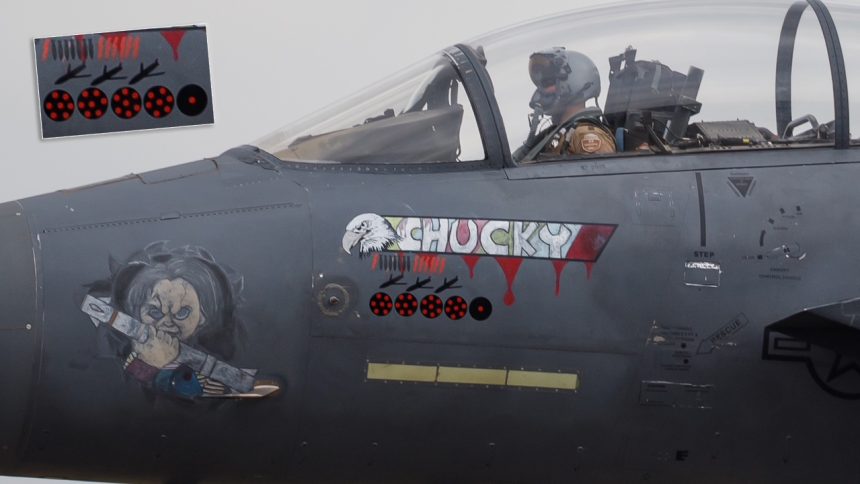The F-15E Strike Eagles returning to their home base at Mountain Home Air Force Base, Idaho, feature interesting bomb markings (along with nose art depicting horror movie characters).
Split into two cells (radio callsigns TABOR 81–86 and 91–92) and supported by two KC-46A Pegasus tankers (CLEAN 31 and 32), the first 8 of 12 F-15E Strike Eagles from the 366th Fighter Wing, arrived at RAF Mildenhall, UK, at 08:34 AM local time on Jul. 18, 2025, on their way back to Mountain Home AFB from a Middle East deployment.
The F-15E serials were as follows:
- F-15E 87-0204 366 OG “Guardian”
- F-15E 87-0173 “Freddy”
- F-15E 87-0210 “Jigsaw”
- F-15E 87-0202 “Chucky”
- F-15E 89-0506 “Candyman”
- F-15E 90-0241 “Leatherface”
- F-15E 90-0227 “Michael Myers”
- F-15E 87-0183 “Nightmare”
The aircraft had deployed to Jordan in October 2024 amid rising tensions between Israel and Iran. Their mission was described as a deterrent to aggression and a measure to reduce the risk of a broader regional conflict, as tensions had further escalated following Israel’s targeted assassination of Hezbollah leader Hassan Nasrallah in Lebanon. At the time, U.S. officials cited threats from Iran of an imminent ballistic missile attack on Israel, issued just hours after the announcement of the U.S. posture reinforcement. That threat materialized on the evening of Oct. 1, 2024, and on Oct. 7, the Strike Eagles from Mountain Home AFB transitioned through RAF Lakenheath en route to the sandpit.
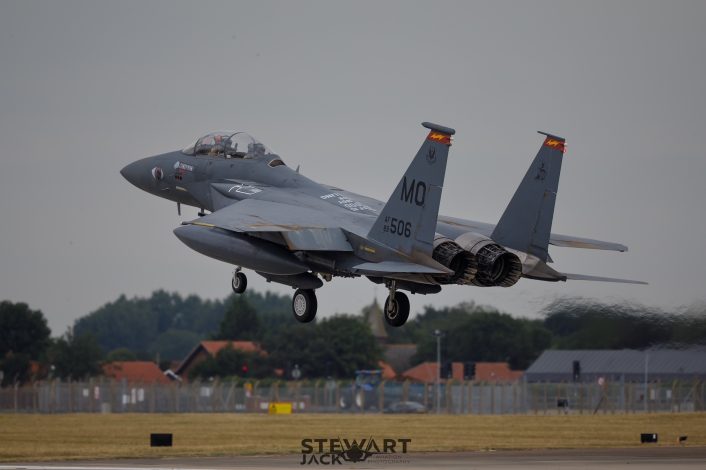
AGM-158 and APKWS markings
Very few details have been disclosed about the missions flown by the Mountain Home AFB’s aircrews of the 389th Fighter Squadron during the latest deployment. However, judging from the bomb markings on the aircraft, along with the traditional nose art featuring horror movie characters, the F-15Es appear to have been quite active. In addition to what look like JDAMs (Joint Direct Attack Munitions), the Strike Eagles seem to have employed both AGM-158 JASSMs (Joint Air-to-Surface Standoff Missiles) and AGR-20 APKWS II (Advanced Precision Kill Weapon System II) laser-guided rockets. Among the easily recognizable silhouettes, there are also some red lightning bolts that likely represent an unidentified type of weapon.
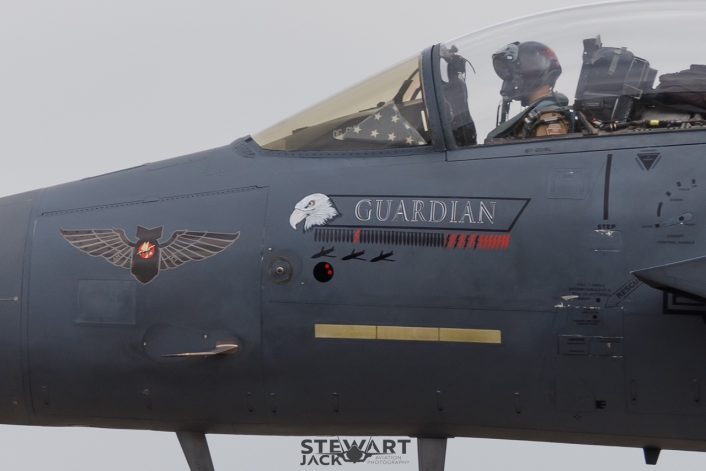
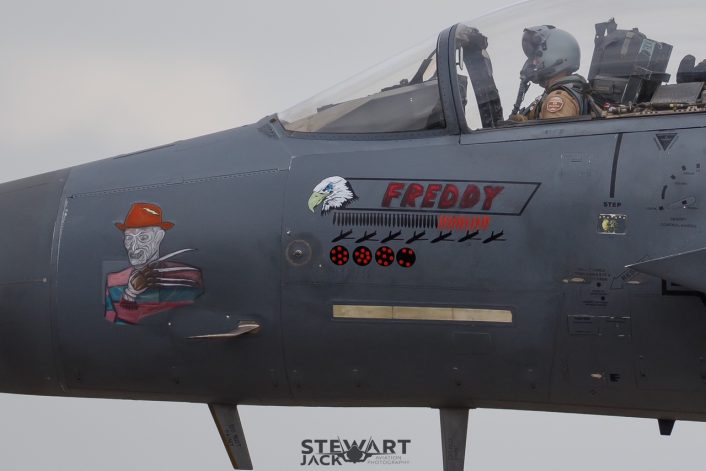
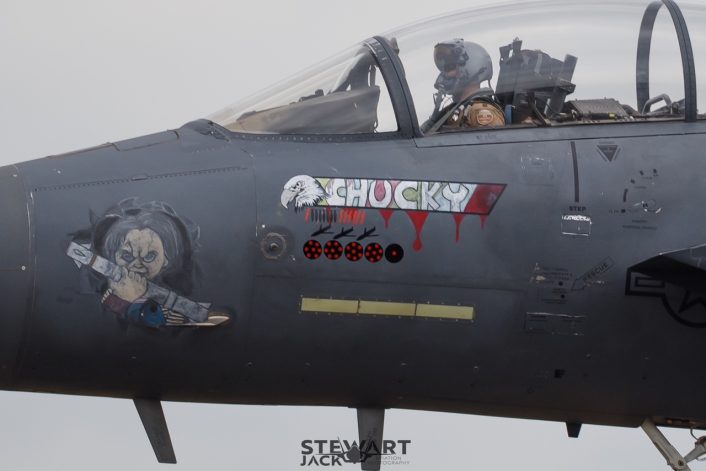
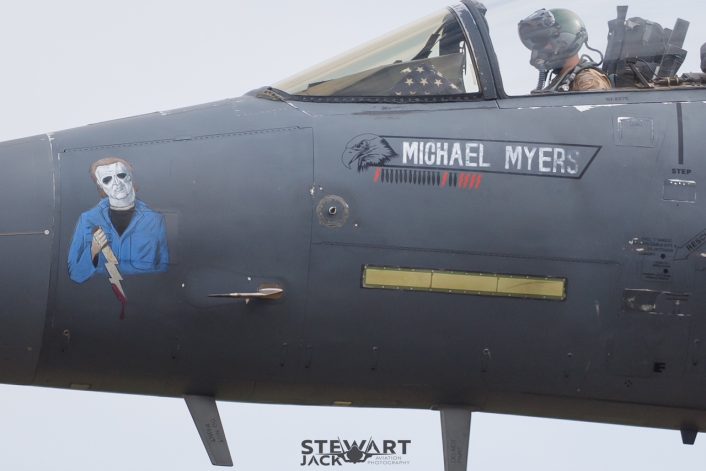
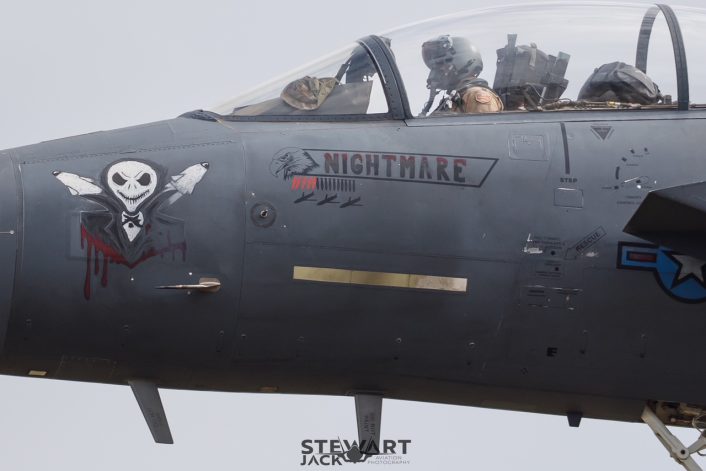
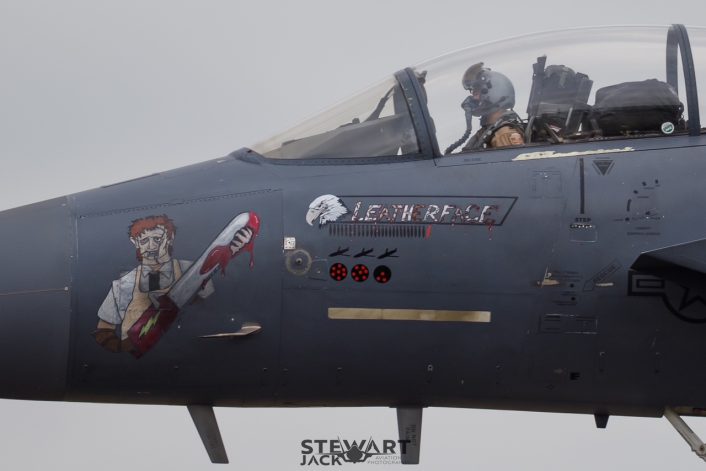
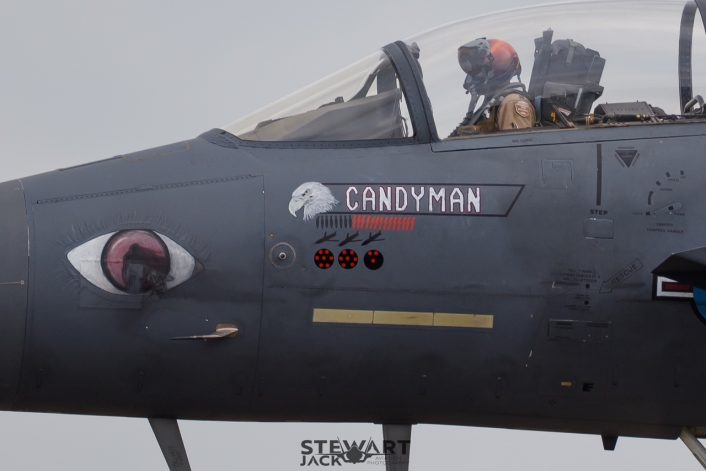
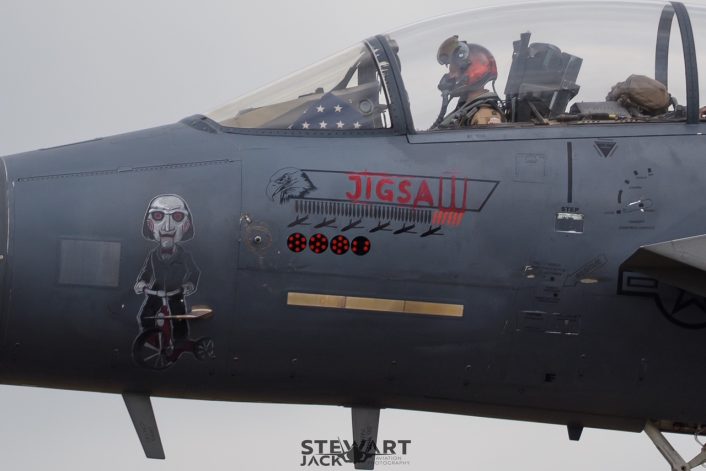
While the use of the AGR-20 APKWS II was somewhat expected, especially after CENTCOM shared a photo of an F-15E (87-0210 – “Jigsaw”) deployed to an undisclosed base later identified through OSINT as Muwaffaq Salti Air Base in Jordan, carrying an anti-UAV loadout consisting of six LAU-131A rocket launchers for a total of 42 AGR-20 rockets, the employment of AGM-158 JASSMs by the F-15Es in the Middle East has not been officially confirmed.
*took 3 minutes.
— Evergreen Intel (@vcdgf555) May 30, 2025
The AGM-158s, both the baseline variant with a range in excess of 200 NM and the -ER version, with a standoff distance of over 500 NM, are GPS-guided radar-evading cruise missiles with 2,250-lbs penetrator/blast fragmentation warhead. The JASSM cruise missile employs precision routing and guidance in adverse weather, day or night, using an infrared seeker in addition to the anti-jam GPS to find and destroy high-value, well-defended targets.
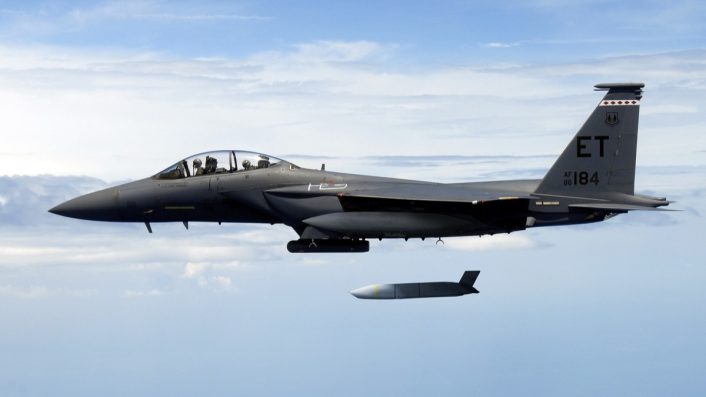
In 2021, the 85th Test and Evaluation Squadron, loaded six inert GBU-38 JDAMs on a single side of an F-15E, in a PoC (Proof of Concept) whose aim was to increase the carrying capacity of the Strike Eagle from 9 to 15 JDAMs, so it could act as a “bomb truck” and move fully assembled bombs that could be used at remote location to rearm the F-15E itself or other aircraft.
And two months later, on Apr. 25, 2021, six F-15Es of the 494th Expeditionary Fighter Squadron from RAF Lakenheath relocated to Al Dhafra Air Base (United Arab Emirates) for the first time in the new “Bomb Truck” configuration (each carrying 12 JDAMs and 4 SDBs).
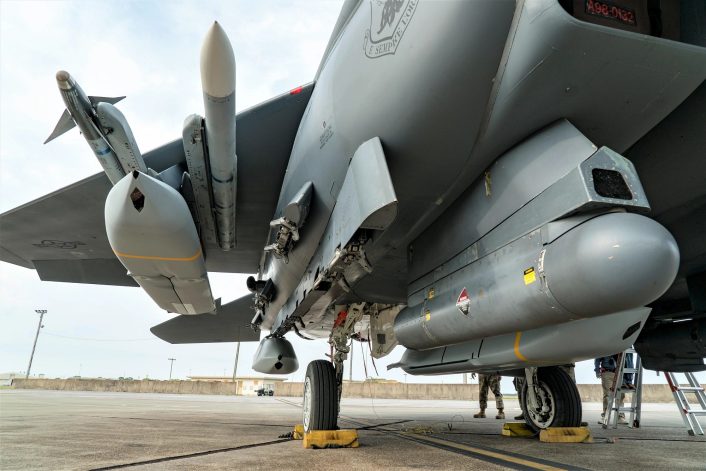
The JASSM markings on the F-15Es suggest they were used in the region, possibly in support of Operation Midnight Hammer that targeted Iran’s nuclear sites last month. Noteworthy, the F-15Es are also slated to integrate the AGM-158C-1 LRASM (Long Range Anti-Ship Missile) which were reportedly used in combat for the first time in the Middle East lately.
Dealing with the integration of the APKWS on the F-15E, here’s what we wrote in a previous story here at The Aviationist:
[…] the weapon has recently been introduced in the air-to-air role by the U.S. Air Force’s F-16s engaged in drone intercept missions around the Red Sea.
Originally designed as a low-cost, laser-guided precision munition for air-to-ground targets, APKWS II was first tested for air-to-air use in 2019. It offers an affordable option for engaging slow-moving aerial threats such as drones and cruise missiles. During recent operations, F-16s have typically worked in pairs: one aircraft designated the target using the Sniper Advanced Targeting Pod, while the other executed the attack run with the rockets.
Compared to traditional air-to-air missile loadouts, the APKWS configuration allowed the F-16 to increase its engagement capacity significantly. While a standard load of AIM-9X and AIM-120 missiles offers six shots, carrying one or two rocket pods with APKWS enabled the Viper to triple that number. This was achieved at a fraction of the cost as each APKWS rocket is estimated at around 30,000 USD, while an AIM-9X costs approximately 450,000 USD and an AIM-120 exceeds 1 million USD per unit. The tradeoff, however, is that APKWS rockets are only effective against predictable targets with limited maneuverability.
The loadout recently tested on the F-15E takes the concept even further. With six LAU-131 pods installed, the Strike Eagle can carry up to 42 APKWS rockets in addition to its standard complement of eight air-to-air missiles. This gives the aircraft up to 50 engagement opportunities before even accounting for the internal gun. The layout also provides greater operational flexibility: the Weapons Systems Officer in the back seat can laser-designate targets using the Sniper ATP while the pilot concentrates on the engagement, eliminating the need for paired operations like those conducted with the F-16.
The integration of APKWS II on the Strike Eagle appears to be a logical evolution. During the April 2024 Iranian drone attack against Israel, F-15Es were among the aircraft tasked with intercepting the wave of incoming drones. One of the limiting factors during that operation was the limited number of air-to-air missiles available to each jet. An F-15E outfitted with a high-capacity rocket loadout would significantly extend the duration and effectiveness of counter-UAS sorties.
APKWS II has already been fielded across several U.S. platforms, including the USMC’s AV-8B Harrier and F/A-18C/D Hornets, AH-1Z Vipers and UH-1Y Venoms, the USAF’s A-10Cs and F-16s, the U.S. Navy’s MH-60R/S helicopters, and the U.S. Army’s AH-64D/E Apaches.
The APKWS II is based on the Hydra 70 unguided rocket and incorporates a laser guidance kit between the warhead and the rocket motor. This low-cost modification transforms a simple unguided munition into a precision weapon. The system uses four pop-out wings with laser-seeker optics, known as the Distributed Aperture Semi-Active Laser Seeker (DASALS), which provide wide field-of-view tracking for both stationary and moving targets.
To further enhance its counter-UAS capabilities, the APKWS underwent an upgrade under the Fixed Wing, Air Launched, Counter-Unmanned Aircraft Systems Ordnance (FALCO) program. The AGR-20 FALCO version includes updated software that improves its performance in air-to-air roles. This variant is already in use within the CENTCOM area of responsibility and has demonstrated a high probability of kill in operational scenarios.
In addition, BAE Systems has revealed a new infrared seeker for the APKWS II, complementing the laser guidance and making the rocket a dual-mode weapon. This enhancement builds upon the FALCO upgrade and is expected to further improve the Air Force’s ability to counter a wide range of aerial threats.
By the way, nose art on deployed Strike Eagles first appeared on the 18 F-15E Strike Eagle jets belonging to the 391st Expeditionary Fighter Squadron returning to Mountain Home AFB from OIR (Operation Inherent Resolve) in April 2019. Since then, it has become a standard for all the F-15E squadrons deployed to the CENTCOM area of responsibility.
A big shoutout to our friend and contributor Stewart Jack for the photos!

